HONDA ACCORD HYBRID 2019 Manual PDF
Manufacturer: HONDA, Model Year: 2019, Model line: ACCORD HYBRID, Model: HONDA ACCORD HYBRID 2019Pages: 727, PDF Size: 24.78 MB
Page 71 of 727
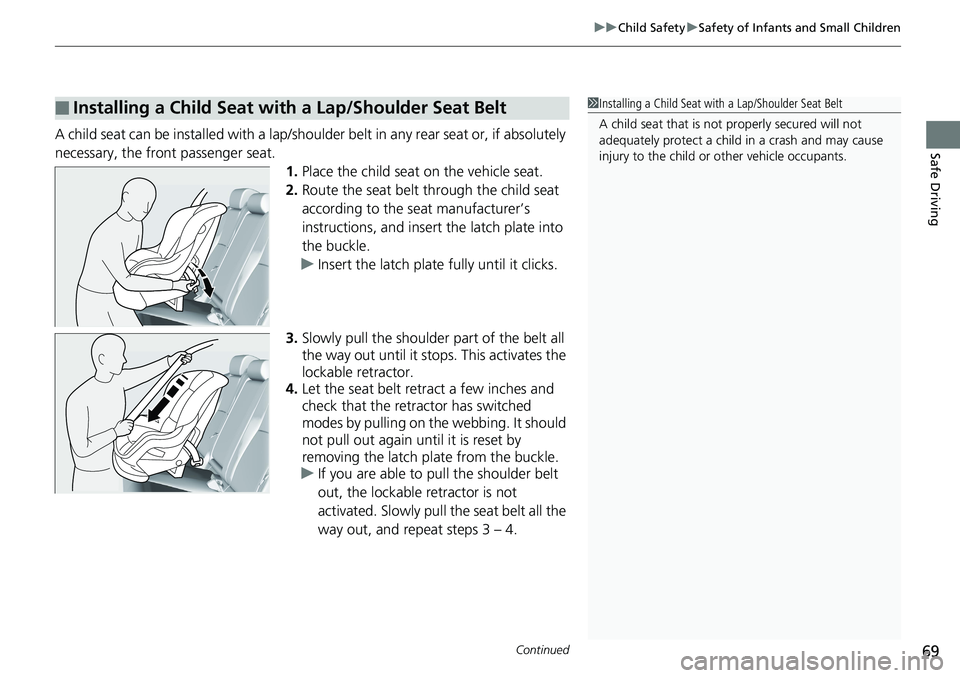
Continued
69uu Child Safety u Safety of Infants and Small Children
Safe Driving
A child seat can be installed with a lap/should er belt in any rear seat or, if absolutely
necessary, the front passenger seat.
1. Place the child seat on the vehicle seat.
2. Route the seat belt through the child seat
according to the seat manufacturer’s
instructions, and insert the latch plate into
the buckle.
u Insert the latch plate fully until it clicks.
3. Slowly pull the shoulder part of the belt all
the way out until it stops. This activates the
lockable retractor.
4. Let the seat belt retract a few inches and
check that the retractor has switched
modes by pulling on the webbing. It should
not pull out again until it is reset by
removing the latch pl ate from the buckle.
u If you are able to pull the shoulder belt
out, the lockable retractor is not
activated. Slowly pull the seat belt all the
way out, and repeat steps 3 – 4.■ Installing a Child Seat with a Lap/Shoulder Seat Belt 1 Installing a Child Seat with a Lap/Shoulder Seat Belt
A child seat that is not properly secured will not
adequately protect a child in a crash and may cause
injury to the child or other vehicle occupants.
Page 72 of 727
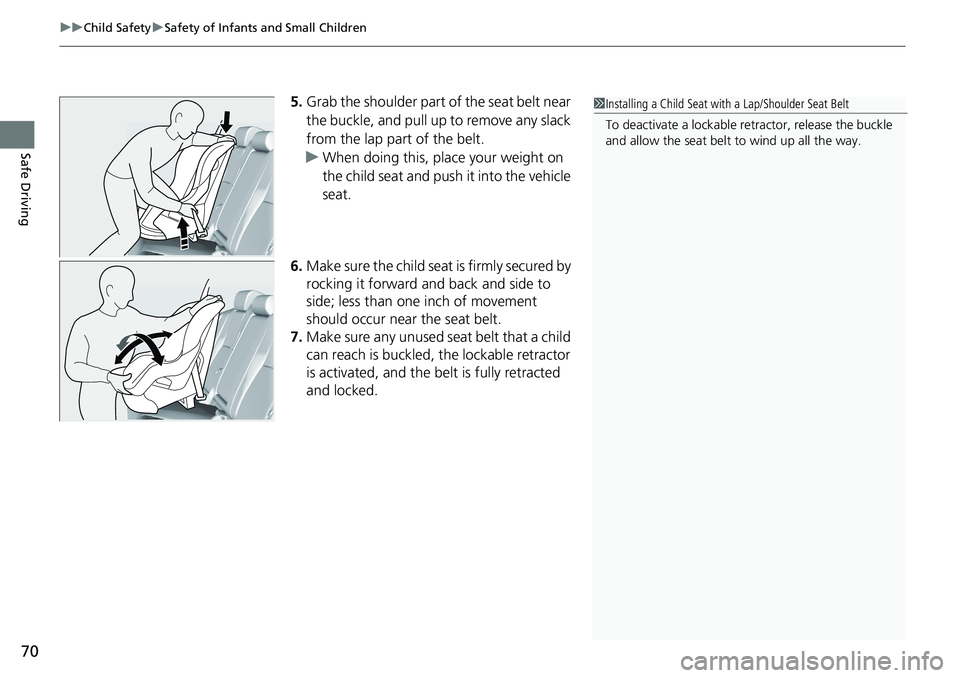
uu Child Safety u Safety of Infants and Small Children
70
Safe Driving 5. Grab the shoulder part of the seat belt near
the buckle, and pull up to remove any slack
from the lap part of the belt.
u When doing this, place your weight on
the child seat and push it into the vehicle
seat.
6. Make sure the child seat is firmly secured by
rocking it forward and back and side to
side; less than one inch of movement
should occur near the seat belt.
7. Make sure any unused se at belt that a child
can reach is buckled, the lockable retractor
is activated, and the be lt is fully retracted
and locked. 1 Installing a Child Seat with a Lap/Shoulder Seat Belt
To deactivate a lockable retractor, release the buckle
and allow the seat belt to wind up all the way.
Page 73 of 727
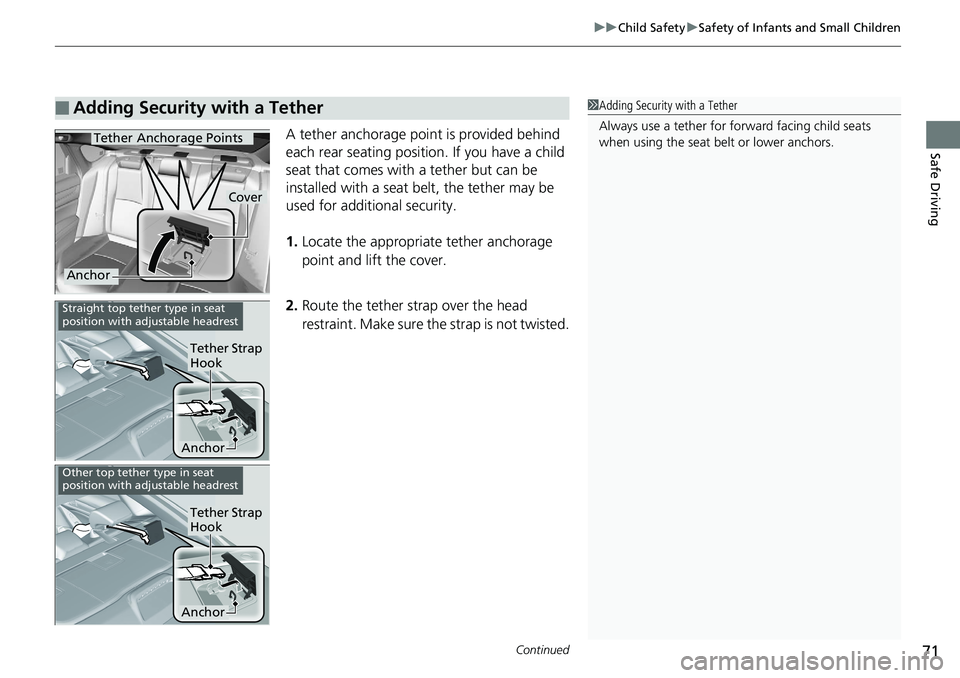
Continued
71uu Child Safety u Safety of Infants and Small Children
Safe Driving
A tether anchorage point is provided behind
each rear seating positi on. If you have a child
seat that comes with a tether but can be
installed with a seat belt, the tether may be
used for additional security.
1. Locate the appropriate tether anchorage
point and lift the cover.
2. Route the tether strap over the head
restraint. Make sure the strap is not twisted.■ Adding Security with a Tether 1 Adding Security with a Tether
Always use a tether for forward facing child seats
when using the seat be lt or lower anchors.Tether Anchorage Points
Cover
Anchor
Anchor Tether Strap
HookStraight top tether type in seat
position with adjustable headrest
Anchor Tether Strap
HookOther top tether type in seat
position with adjustable headrest
Page 74 of 727
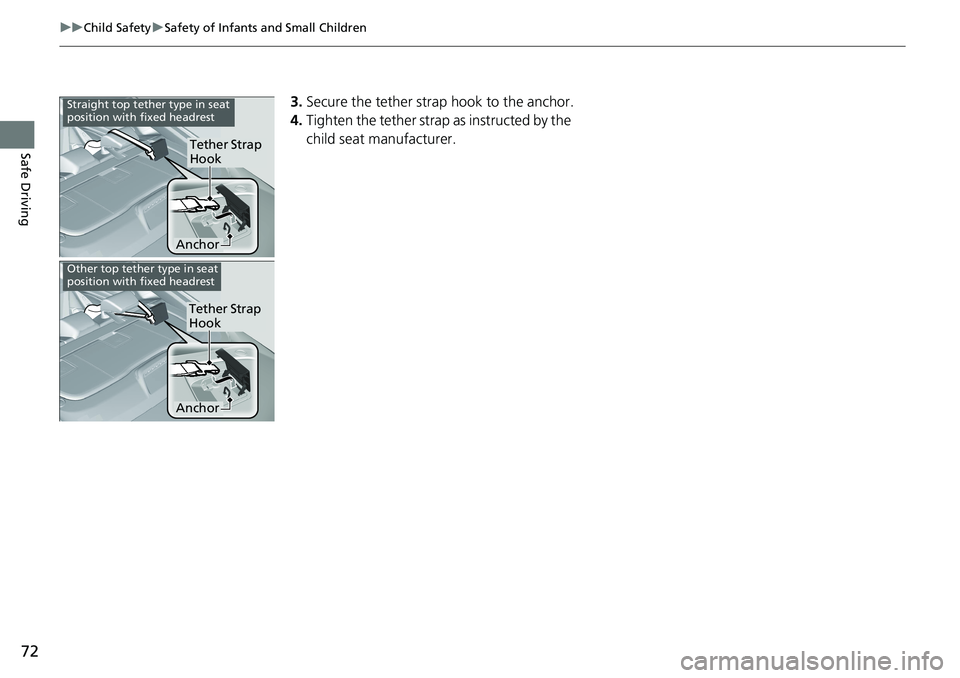
72 uu Child Safety u Safety of Infants and Small Children
Safe Driving 3. Secure the tether strap hook to the anchor.
4. Tighten the tether strap as instructed by the
child seat manufacturer.
Anchor Tether Strap
HookStraight top tether type in seat
position with fixed headrest
Anchor Tether Strap
HookOther top tether type in seat
position with fixed headrest
Page 75 of 727
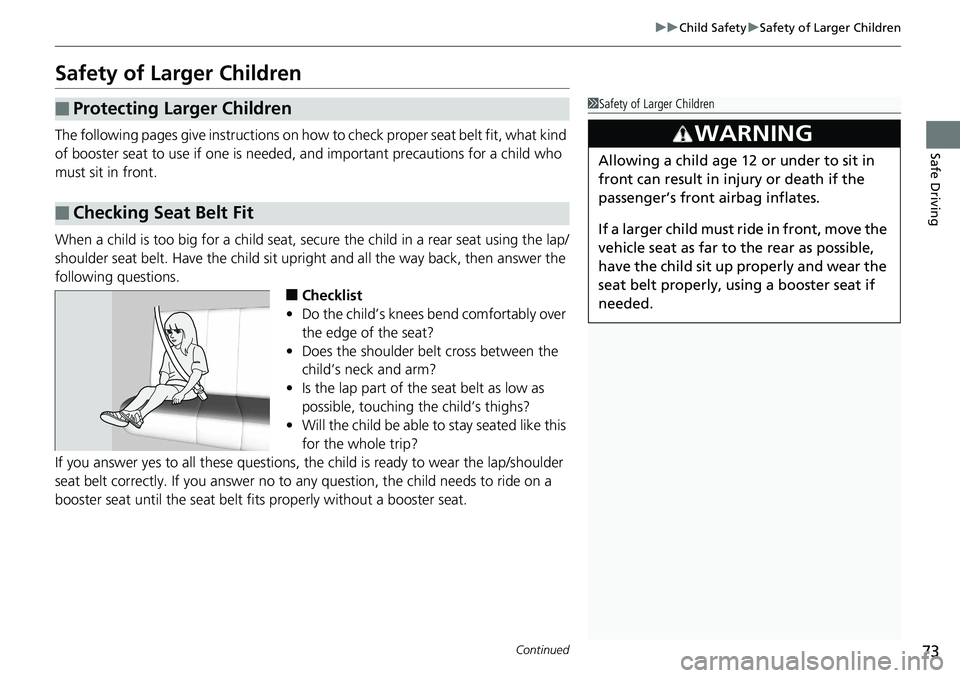
73uu Child Safety u Safety of Larger Children
Continued
Safe Driving
Safety of Larger Children The following pages give instructions on how to check proper seat belt fit, what kind
of booster seat to use if one is needed, and important precautions for a child who
must sit in front.
When a child is too big for a child seat, secure the child in a rear seat using the lap/
shoulder seat belt. Have the child sit upri ght and all the way back, then answer the
following questions.
■ Checklist
• Do the child’s knees bend comfortably over
the edge of the seat?
• Does the shoulder belt cross between the
child’s neck and arm?
• Is the lap part of the seat belt as low as
possible, touching the child’s thighs?
• Will the child be able to stay seated like this
for the whole trip?
If you answer yes to all these questions, th e child is ready to w ear the lap/shoulder
seat belt correctly. If you answer no to any question, the child needs to ride on a
booster seat until the seat belt fits properly without a booster seat.■ Protecting Larger Children
■ Checking Seat Belt Fit 1 Safety of Larger Children
3
WARNING Allowing a child age 12 or under to sit in
front can result in injury or death if the
passenger’s front airbag inflates.
If a larger child must ri de in front, move the
vehicle seat as far to the rear as possible,
have the child sit up properly and wear the
seat belt properly, us ing a booster seat if
needed.
Page 76 of 727
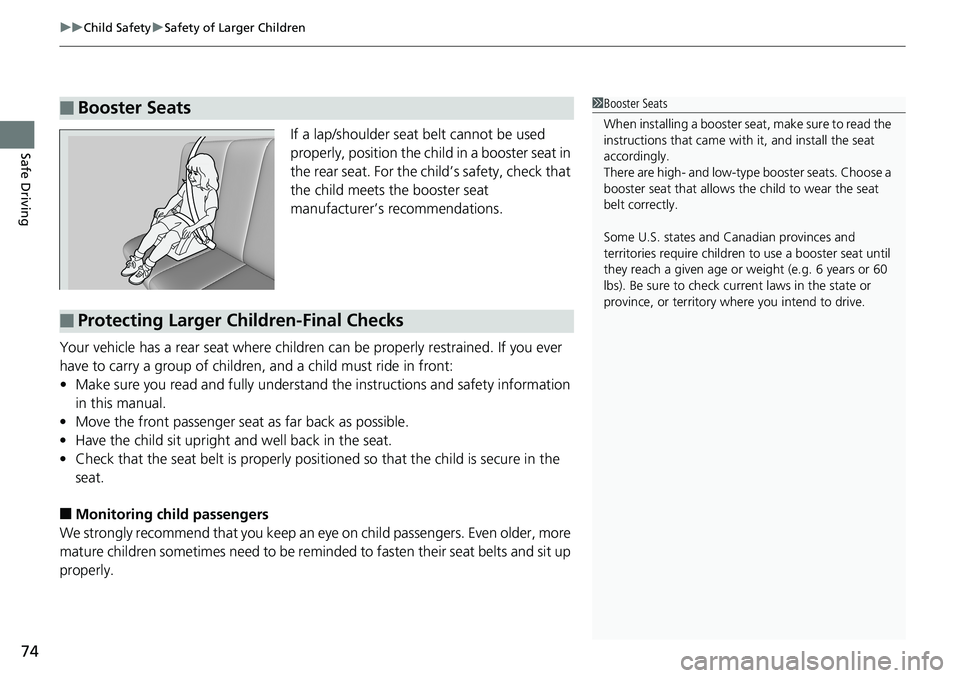
uu Child Safety u Safety of Larger Children
74
Safe Driving If a lap/shoulder seat belt cannot be used
properly, position the child in a booster seat in
the rear seat. For the ch ild’s safety, check that
the child meets the booster seat
manufacturer’s recommendations.
Your vehicle has a rear seat where children can be properly restrained. If you ever
have to carry a group of children, and a child must ride in front:
• Make sure you read and full y understand the instructio ns and safety information
in this manual.
• Move the front passenger seat as far back as possible.
• Have the child sit upright and well back in the seat.
• Check that the seat belt is properly posi tioned so that the child is secure in the
seat.
■ Monitoring child passengers
We strongly recommend that you keep an eye on child passengers. Even older, more
mature children sometimes need to be remind ed to fasten their seat belts and sit up
properly.■ Booster Seats 1 Booster Seats
When installing a booster seat, make sure to read the
instructions that came with it, and install the seat
accordingly.
There are high- and low-type booster seats. Choose a
booster seat that allows the child to wear the seat
belt correctly.
Some U.S. states and Canadian provinces and
territories require children to use a booster seat until
they reach a given age or weight (e.g. 6 years or 60
lbs). Be sure to check current laws in the state or
province, or territory where you intend to drive.
■ Protecting Larger Children-Final Checks
Page 77 of 727
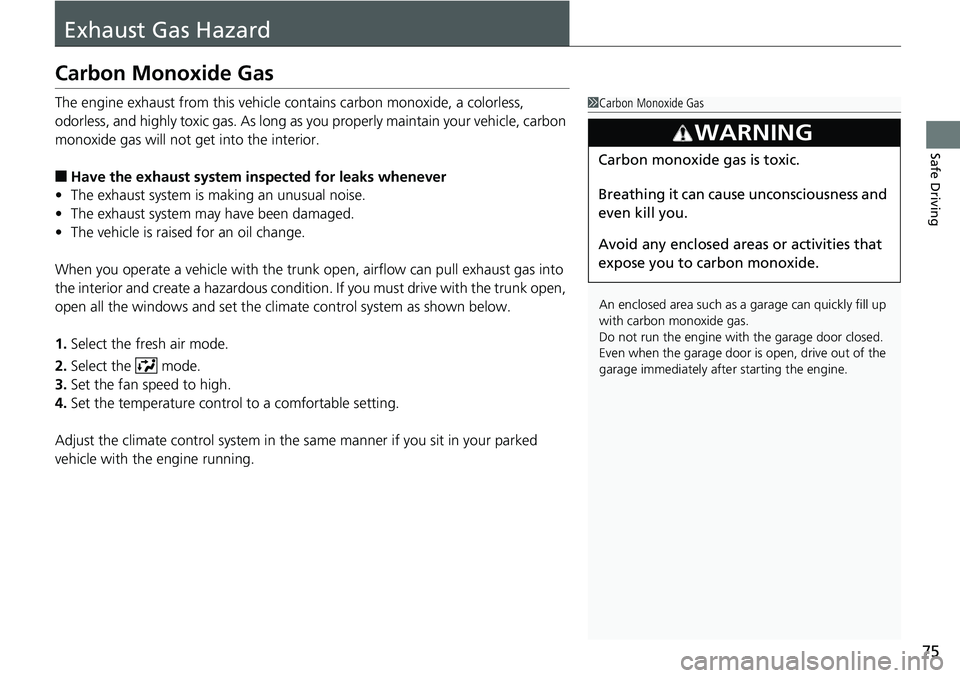
75
Safe Driving
Exhaust Gas HazardCarbon Monoxide Gas The engine exhaust from this vehicle contains carbon monoxide, a colorless,
odorless, and highly toxic gas. As long as you properly maintain your vehicle, carbon
monoxide gas will not get into the interior.
■ Have the exhaust system in spected for leaks whenever
• The exhaust system is ma king an unusual noise.
• The exhaust system may have been damaged.
• The vehicle is raised for an oil change.
When you operate a vehicle with the trunk open, airflow can pull exhaust gas into
the interior and create a hazardous condition. If you must drive with the trunk open,
open all the windows and set the climate control system as shown below.
1. Select the fresh air mode.
2. Select the mode.
3. Set the fan speed to high.
4. Set the temperature control to a comfortable setting.
Adjust the climate control system in the same manner if you sit in your parked
vehicle with the engine running. 1 Carbon Monoxide Gas
An enclosed area such as a garage can quickly fill up
with carbon monoxide gas.
Do not run the engine with the garage door closed.
Even when the garage door is open, drive out of the
garage immediately afte r starting the engine.3
WARNING Carbon monoxide gas is toxic.
Breathing it can cause unconsciousness and
even kill you.
Avoid any enclosed areas or activities that
expose you to carbon monoxide.
Page 78 of 727
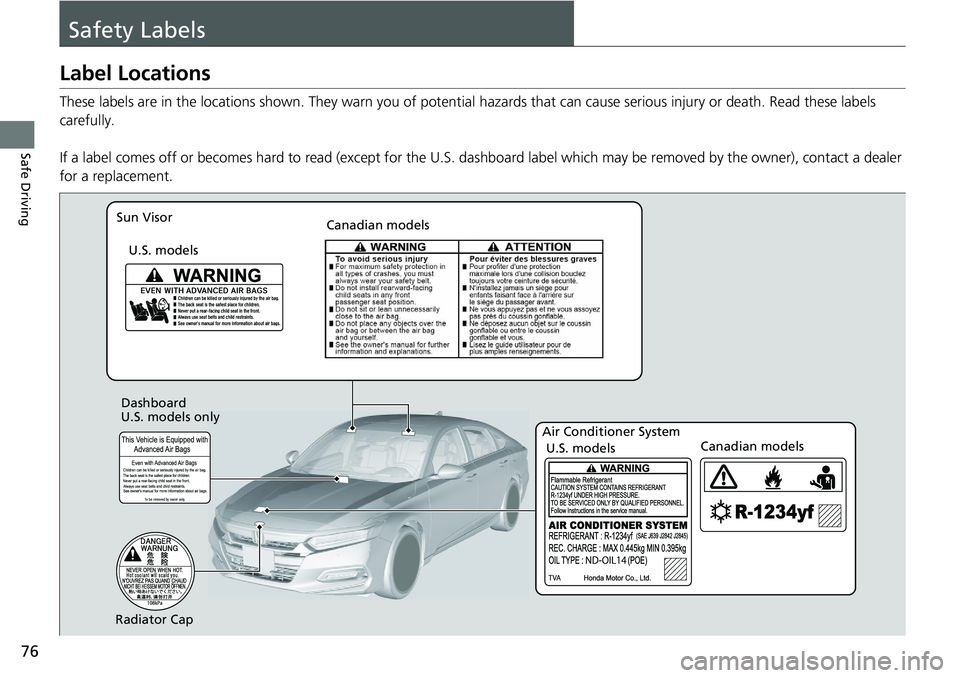
76
Safe Driving Safety LabelsLabel Locations These labels are in the locations shown. Th ey warn you of potential hazards that can cause serious injury or death. Read these labels
carefully.
If a label comes off or becomes hard to read (except for the U. S. dashboard label which may be removed by the owner), contact a dealer
for a replacement. Sun Visor
U.S. models Canadian models
Radiator Cap U.S. models only Dashboard
U.S. models Canadian modelsAir Conditioner System
Page 79 of 727
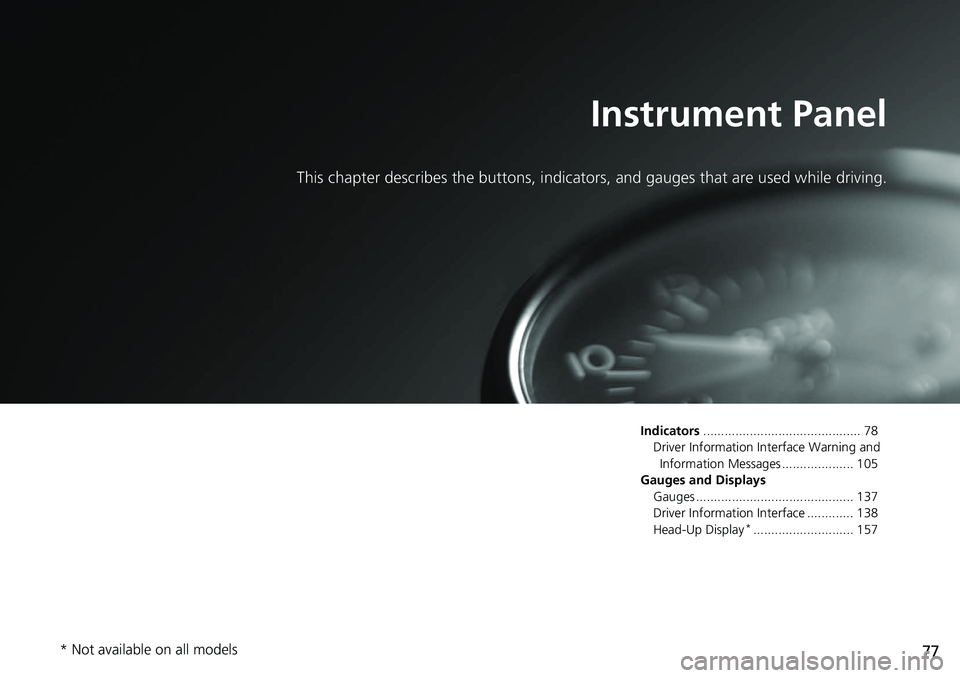
77Instrument Panel This chapter describes the buttons, indicators, and gauges that are used while driving.
Indicators ............................................ 78
Driver Information Interface Warning and
Information Messages .................... 105
Gauges and Displays
Gauges ............................................ 137
Driver Information Interface ............. 138
Head-Up Display *
............................ 157
* Not available on all models
Page 80 of 727
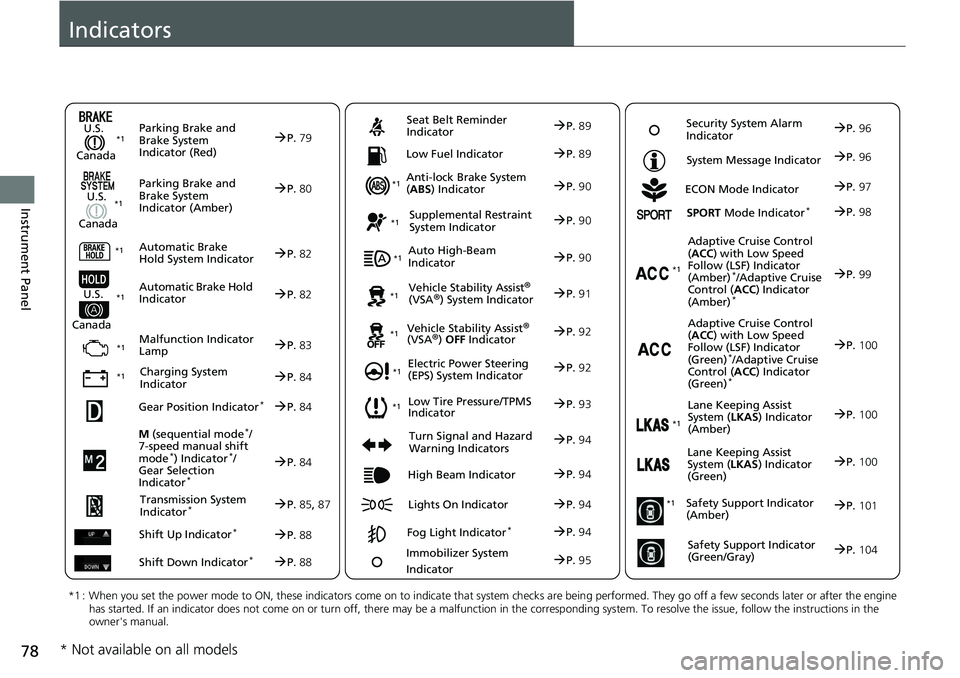
78
Instrument Panel Indicators
M (sequential mode *
/
7-speed manual shift
mode *
) Indicator *
/
Gear Selection
Indicator *
P. 84Parking Brake and
Brake System
Indicator (Red)
Parking Brake and
Brake System
Indicator (Amber)U.S.
Canada
U.S.
Canada
Automatic Brake
Hold System Indicator
Automatic Brake Hold
IndicatorU.S.
Canada
*1 : When you set the power mode to ON, these indicators come on to indicate that system checks are being perf ormed. They go off a few seconds later or after the engine
has started. If an indicator does not come on or turn off, th ere may be a malfunction in the co rresponding system. To resolve t he issue, follow the instructions in the
owner's manual. P. 79*1
Malfunction Indicator
Lamp
Charging System
Indicator Anti-lock Brake System
( ABS ) IndicatorSeat Belt Reminder
Indicator
Low Fuel Indicator
Vehicle Stability Assist
® (VSA
® ) System Indicator
Vehicle Stability Assist
® (VSA
® ) OFF IndicatorSupplemental Restraint
System Indicator
Auto High-Beam
Indicator
Low Tire Pressure/TPMS
IndicatorElectric Power Steering
(EPS) System Indicator
Turn Signal and Hazard
Warning Indicators
Lights On IndicatorHigh Beam Indicator
Fog Light Indicator *ECON Mode Indicator System Message Indicator
SPORT Mode Indicator *
Adaptive Cruise Control
( ACC ) with Low Speed
Follow (LSF) Indicator
(Amber) *
/Adaptive Cruise
Control ( ACC ) Indicator
(Amber) *
Lane Keeping Assist
System ( LKAS ) Indicator
(Amber)
Safety Support Indicator
(Amber)
Safety Support Indicator
(Green/Gray) P. 80
P. 82
P. 82
P. 83
P. 84*1
*1
*1 *1
P. 93*1
*1
Gear Position Indicator *
P. 84
Transmission System
Indicator *
P. 85 , 87
Shift Up Indicator *
P. 88
Shift Down Indicator *
P. 88 P. 89
P. 89
P. 90
P. 90
P. 90
P. 91*1
*1
*1
*1
P. 92*1
P. 92
P. 94 P. 99
*1
P. 94
P. 94 P. 97
P. 94
Immobilizer System
Indicator
P. 95 Security System Alarm
Indicator
P. 96
P. 96
P. 98
P. 100
P. 101
P. 104 *1
Adaptive Cruise Control
( ACC ) with Low Speed
Follow (LSF) Indicator
(Green) *
/Adaptive Cruise
Control ( ACC ) Indicator
(Green) *
P. 100 *1
Lane Keeping Assist
System ( LKAS ) Indicator
(Green)
P. 100 *1
* Not available on all models